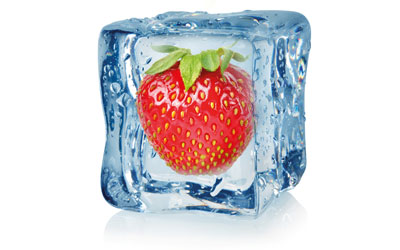Refrigeration: Can magnetism improve the storage of foods?
- Like
- Digg
- Del
- Tumblr
- VKontakte
- Buffer
- Love This
- Odnoklassniki
- Meneame
- Blogger
- Amazon
- Yahoo Mail
- Gmail
- AOL
- Newsvine
- HackerNews
- Evernote
- MySpace
- Mail.ru
- Viadeo
- Line
- Comments
- Yummly
- SMS
- Viber
- Telegram
- Subscribe
- Skype
- Facebook Messenger
- Kakao
- LiveJournal
- Yammer
- Edgar
- Fintel
- Mix
- Instapaper
- Copy Link
Posted: 23 April 2015 | Christian James, Graham Purnell & Stephen J James, Food Refrigeration and Process Engineering Research Centre, Grimsby Institute of Further and Higher Education | No comments yet
Frozen food is one of the largest sectors of the food industry and its value is increasing throughout the world. According to market research by Food For Thought, the frozen food market in seven of the major Western European economies was valued at €83.51 billion in 2013 and is expected to grow in value by approximately 11% by 2016.


The market is broadly segmented into frozen; vegetables and fruits, potatoes, ready meals, meat, fish/seafood and soup. More than 35% of the market is frozen ready meals. There is a general view that fast freezing, and the formation of small ice crystals, offers some quality advantages. Although not true for all foods, minimising freezing times can be advantageous in reducing energy consumption, increasing throughput, and improving yield.
In a previous article in this magazine we discussed different innovative freezing technologies for foods. In this article we look in detail at one of these technologies. As discussed previously there is growing interest in finding a freezing method that will give a long shelf life but preserve the intrinsic ‘fresh’ quality of food. Being able to freeze and then thaw a strawberry without product damage is often seen to be the ‘Holy Grail’ of freezing. The application of fluctuating magnetic fields, especially the Cells Alive System (CAS), has been advocated in this role.
Magnetic resonance assisted freezing
CAS is a system patented by the Japanese company ABI (ABI Corporation Ltd, Chiba, Japan), which claims to provide a process where a product can be frozen ‘in such a manner as to approximate the quality of a fresh product once thawed’. The technique uses permanent magnets and induction coils to produce a weak oscillating magnetic field within the freezing chamber. CAS is not a refrigeration process itself, but is claimed to assist in improving existing freezing and frozen storage processes (both in terms of process speeds and product quality). It is claimed in the CAS patent literature that the oscillating magnetic field acts on polarised water molecules to delay formation of ice crystals3,4.
Whether this is due to engendering of super-cooling, or movement of the molecules during the ice formation process, is unclear from any of the ABI literature or patents. However, the claimed consequence is that because of the delay in ice formation, most of the ice crystals form at the same time, thus restricting their size. It is assumed that small ice crystals will result in less cellular damage to the food during freezing and frozen storage, and therefore in less structural damage to product after thawing.
When our research group moved to the Grimsby Institute in 2009, it gained access to a number of CAS systems that had recently been purchased by the Institute. Since then we have been looking at the science behind magnetic field freezing and its practical application in the food industry. Frustratingly, despite the great claims for CAS5, we found very few peer-reviewed studies on the freezing, storage and thawing of food under magnetic fields. Studies previously carried out at the Grimsby Institute had also failed to scientifically demonstrate any clear commercial advantages of CAS systems, although there were tantalising reports of some trials showing ‘improvements’ in various sensory properties of some foods in comparison with conventional freezing2.
Scientific evidence
So what scientific evidence is there? Water is the key component in food freezing and there is evidence that water, being a diamagnetic material, can be magnetised in a magnetic field. Woo & Mukumdar6 cite a number of independent studies that have demonstrated that freezing water under the influence of a magnetic field can change its freezing characteristics. For example, Zhou et al.7 looked at the supercooling and crystallization of tap water under DC magnetic fields. They found that increasing the magnetic field intensity increased the degree of super cooling. If the oscillating magnetic field measured in the CAS unit at Grimsby has a similar effect, at its maximum field of 9×10-4T, the effect on super cooling is likely to be <0.15°C. However, the same work shows that there could be up to a 40% increase in crystallisation growth time.
There has been some interest in the medical application of oscillating magnetic fields (OMF). For example, Bassett et al.8 reported that a 0.2mT magnetic field was effective for healing bone fractures in human and Oshibuchi9 reported that a 10mT magnetic field was effective for healing wounds in mice. A number of papers have been published in recent years on OMF assisted freezing of biological samples (such as teeth) using ABI equipment10-12 and even on whole-organism survival of super cooled organisms like drosophila13.
The biological studies are hard to quantify due to a small number of replicates and differences in freezing rates but do indicate some beneficial effects of magnetic fields. The drosophila studies are more convincing, showing a clear effect of a 30Hz 0.5mT field on their survival for different times at different super cooled temperatures. After 12 hours at -2°C, 92% of the drosophila under the OMF survived compared with under 17% of the controls. After one hour at -8°C, 85% survived compared with none of the controls. The authors concluded that “Indeed it remains unclear whether the Drosophila are frozen or not under these conditions, but it is certain that a very weak magnetic field affects the life or death of such Drosophila under super-cooled conditions.”
Studies on food
Currently we know of only four peer reviewed published studies on the freezing of foodstuffs exposed to oscillating weak magnetic fields. The findings of Suzuki et al.14 and Watanabe et al.15 were unfortunately negative. Using a ‘copy’ of the ABI CAS system, they found that oscillating weak magnetic fields had no effect on the freezing curves of sweet potato, spinach, fish, agar gel or water, and had no visible effect on cellular microstructures of the tissues they examined.
In contrast, Kim et al.16 have claimed positive effects of magnetic resonance freezing in terms of faster freezing and lower drip losses in meat. Unfortunately, since the bulk of the paper is in Korean we can only examine in detail the summary and the tables and figures of results, which are in English. This appears to show that in their study they do not appear to have compared like with like. The air blast freezer they used for the magnetic resonance freezing was different to the air blast freezer used for their conventional comparison trials and the operating temperatures were also different. They carried out magnetic resonance freezing in air at -55°C, while the conventional air blast freezing was carried out at operating temperatures of -45°C and -20°C (although the published temperature curves indicate that actual temperatures in the conventional air blast were nearer -40°C and -15°C).
Thus much of the difference in freezing time and product quality that they claim may be attributed to the difference in operating conditions and not the use of a magnetic field, the details of which do not appear to be in the paper. Their summary reports freezing times of two hours under the magnetic field compared with eight hours in the blast freezer at -45°C. However, the freezing curves in the paper show that with two of the six products, the -45°C samples were below -20°C in less than two hours and the other four in much less than four hours. Although in general, drip losses under magnetic fields were lower than without, with chicken legs the drip was much higher. Interestingly in most examples they also report higher cooking losses.
The fourth peer reviewed paper is ours17, produced using the ABI CAS freezer at the Grimsby Institute. It describes a short study we carried out to investigate what effect freezing under OMF conditions had on the degree of super-cooling and characteristics of the freezing curve of individual cloves within whole garlic bulbs when compared to freezing under the same conditions without OMF. Garlic was chosen as the test material since a previous study by us has shown it to significantly super-cool during conventional freezing. Overall, these results clearly indicate that freezing under the OMF conditions used in these experiments had little significant additional effect on the freezing characteristics, or degree of super-cooling, of garlic bulbs, in comparison with freezing under the same environment without OMF.
Trials at FRPERC on CAS have included fruit, vegetables, meat and fish products. The majority of these trials have been for commercial customers and thus the data is not in the public domain. Predominantly, trials have considered the effect of different CAS settings on food quality aspects including; dimensions, weights, drip loss, colour, moisture content, sugar content and texture. We have also looked at the temperature change curves during the freezing process to assess whether CAS has any effect on rates of temperature change, supercooling and/or ice formation. To date we have seen no strong continuum of effect that prevails across all CAS settings and/or temperatures for any of these products. Some results for specific products have suggested there are possibilities of ‘sweet spots’ of temperature and CAS settings that do produce an effect but these results have not always been repeatable. We are currently preparing manuscripts on CAS freezing and storage of apples, potatoes and strawberries for submission for peer review and publication.
Conclusions
The results of our studies, so far, on CAS unfortunately do not appear to support the patent claims that OMF-assisted freezing enhances super-cooling in foods during freezing for this technology3,4. In our opinion, this does not invalidate ABI’s CAS system as a method of enhancing the quality of frozen foods, however it does suggest that weak OMF may not affect all foods in an equal manner and that any effect will depend on a complex combination of food, freezing rate, magnetic field frequency and storage conditions. The ‘Holy Grail’ of producing a perfect frozen strawberry still remains, for now, tantalisingly out of reach. However, our experience of working in this area has clearly shown to us the interest that the food industry currently has in improving the quality of frozen foods and the importance of continuing to look for a solution.
References
- James, SJ, James, C (2012). Innovative freezing technologies for foods. New Food, 15:4, 21-24.
- Pendrous, R (2009) New freezing technology leaves cells alive and kicking. Food Manufacture, http://www.foodmanufacture.co.uk/Manufacturing/New-freezing-technology-leaves-cells-alive-and-kicking, last accessed 31.03.2015.
- Owada, N, Kurita, S (2001). Super-quick freezing method and apparatus therefore. US Patent US 6250087 B1.
- Owada, N (2007). Highly-efficient freezing apparatus and highly-efficient freezing method. US Patent 7237400 B2.
- Kelly, T (2008) Freeze. Forbes, http://www.forbes.com/forbes/2008/0602/076.html, last accessed 31.03.2015.
- Woo, MW, Mujumdar, AS (2010). Effects of electric and magnetic field on freezing and possible relevance in freeze drying. Drying Technology, 28:4, 433-443.
- Zhou, Z, Zhao, H, Han, J (2012) Supercooling and crystallization of water under DC magnetic fields. CIESC Journal, 63.5, 1404-1408.
- Bassett, CA, Mitchell, SN, Gaston, SR (1981). Treatment of ununited tibial diaphyseal fractures with pulsing electromagnetic fields. Journal of Bone & Joint Surgery, American Volume, 63, 511–523.
- Oshibuchi, H (1975). The experimental studies on the biological effect of the alternating magnetic fields; (1) Observation on the effect to the wound healing and the general condition. Nippon Geka Gakkai Zassi 76; 432–445 Japanese.
- Kaku, M et al. (2010). Cryopreservation of periodontal ligament cells with magnetic field for tooth banking. Cryobiology, 61:1, 73-78.
- Abedini, S et al. (2011). Effects of cryopreservation with a newly-developed magnetic field programmed freezer on periodontal ligament cells and pulp tissues. Cryobiology, 62:3, 181-187.
- Kaku, M et al. (2012). Electric and magnetic fields in cryopreservation: A response. Cryobiology, 64:3, 304-305.
- Naito, M et al.. (2012). Effect of a magnetic field on Drosophila under supercooled conditions. PLoS ONE, 7.
- Suzuki, T et al. (2009). Experimental investigation of effectiveness of magnetic field on food freezing process. Transactions of the Japan Society of Refrigerating and Air Conditioning Engineers. Vol. 26:4, 371-386.
- Watanabe, M, Kanesaka, N, Masuda, K, Suzuki, T (2011). Effect of oscillating magnetic field on supercooling in food freezing. Proceedings of the 23rd IIR International Congress of Refrigeration; refrigeration for sustainable development, August 21–26, Prague, Czech Republic. 1, 2892–2899.
- Kim, YB et al. (2013). Temperature changes during freezing and effect of physicochemical properties after thawing on meat by air blast and magnetic resonance quick freezing. Korean Journal of Food Science of Animal Resources, 33, 763-771.
- James, C, Reitz, BG & James, SJ (2015). The freezing characteristics of garlic bulbs (Allium sativum) frozen conventionally or with the assistance of an oscillating weak magnetic field. Food and Bioprocess Technology, 8:3, 702-708.
About the authors
Christian James is a Food Technology graduate and a Senior Research Fellow at the Food Refrigeration and Process Engineering Research Centre (FRPERC) at the Grimsby Institute. He is also a Visiting Senior Research Fellow in Food Process Engineering at the University of Lincoln, working closely with the National Centre for Food Manufacturing. Chris joined FRPERC in 1993 and has now been active in food process engineering research for over 21 years. He has carried out studies on rapid cooling, initial freezing points and super-cooling, the use of heat pipes and tempering among others. He has also been very active in thermal processing of food. He is author, or co-author, of over 150 publications on these subject areas.
Dr Graham Purnell is a Mechanical Engineer by training and a Senior Research Fellow at the Food Refrigeration and Process Engineering Research Centre (FRPERC) at the Grimsby Institute. He is also a Visiting Senior Research Fellow in Food Process Engineering at the University of Lincoln, working closely with the National Centre for Food Manufacturing. He started his research career at the University of Bristol in 1987 as a member of the Mechanical Engineering Robotics Group, which subsequently became the Advanced Manufacturing and Automation Research Centre (AMARC), when this group closed down Graham joined the MAFF Fellowship for advanced food studies, and subsequently FRPERC. He has written over 60 research papers, numerous project reports, and is inventor on four patent applications.
Stephen James is the Founder and Director of the Food Refrigeration and Process Engineering Research Centre (FRPERC) at the Grimsby Institute. After working at the Meat Research Institute (MRI) and Institute of Food Research – Bristol Laboratory (IFR-BL), he joined the University of Bristol and formed FRPERC in January 1991. In 2009, FRPERC moved to the Grimsby Institute. Over the past 47 years he has carried out research into all aspects of food refrigeration ranging from primary chilling through to domestic handling. He is author, or co-author, of over 450 publications on these subject areas.





